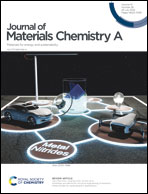Syntheses and electronic structure engineering of transition metal nitrides for supercapacitor applications
Abstract
Supercapacitors are among the most promising energy storage devices; they exhibit a larger power density than batteries but a poor energy density. To meet the ever-increasing demands for energy, it is crucial to develop novel materials that improve the energy storage efficiency. Recent studies have focused on the use of different electrode materials in supercapacitors. Transition metal nitrides offer enormous potential in terms of energy storage because of their layered structure and high electrical conductivity, which promote promising properties in terms of stability, energy and power density, and lifetime. This review elaborates on the recent advances in transition metal nitrides. The different synthesis methods and different transition metal nitrides have been discussed and the electronic structure engineering strategies such as heteroatom-doped metal nitride, heterostructure metal nitride, and multi-metal nitride, have been focused on, which help improve the electrochemical performance of supercapacitors. Finally, the challenges, future direction, and perspectives of transition metal nitride for future direction have been discussed.



 Please wait while we load your content...
Please wait while we load your content...